***some images and video not for the faint-hearted***
We have pocket gophers. Lots of them. We try very hard not to interfere with native plant and animal species on the property. However, in the garden and orchard areas we occasionally find we need to address our pocket gopher population. Burgeoning populations can quickly decimate rows of crops, kill small shrubs and trees, and do significant damage to underground irrigation systems.
When we first moved here it was clear that in some parts of the property we had a healthy pocket gopher population. We knew that some degree of effective gopher control would need to be employed to protect our investment of newly planted fruit trees in the orchard.
Our goal was not to eliminate all gophers from the property. That’s neither reasonable, nor desirable. Although pocket gophers are damaging to crops, they do have benefits. They bury organic matter in the soil, increasing soil fertility. They aerate soils, preventing compaction, and increasing water penetration, thereby decreasing run-off. Their burrow systems are often utilized by other species, including our resident Coast Range Newts, as valuable shelter from weather and predators. Gophers also help to increase the rate of soil formation by bringing subsoil materials to the surface, where they are subjected to weathering. A few gophers aren’t necessarily bad, we just want to prevent the population from getting out of control.
Five species of pocket gophers are found in California. The Botta’s, or Valley Pocket Gopher, Thomomys bottae, is the most widely distributed in this state, and the species we have here. Various species of pocket gopher are found throughout the western two-thirds of the United States, and parts of the southeast.
Regardless as to species, they are all controlled similarly and there are numerous legal methods of gopher control. Popular control methods have included baiting with toxic baits such as Strychnine-treated grain, or anticoagulant rodenticides, or hiring a certified professional to fumigate with aluminum phosphide.
We weren’t interested in using any toxic methods of control, not just to protect our own animals, but also the wild birds and animals here, and to eliminate any risks of residue run-off into the two creeks on the property. We consider this property to be sensitive habitat for numerous native plant and animal species, and have no desire to risk their populations for the sake of controlling a few gophers.
Non-toxic methods of control include trapping, barrier-exclusion methods of control, such as lining garden beds with hardware cloth or gopher wire, wrapping root-balls of sensitive plants in gopher wire, and encouraging natural predators to assist us in keeping populations in check. In the non-cultivated areas of the property we rely on natural predators to keep pocket gopher populations down. Our resident hawks, owls, coyotes, and bobcats are all natural predators of gophers, as is this gopher snake. But honestly, how many gophers can a gopher snake eat in a year?

The Pacific Gopher Snake (Pituophis catenifer catenifer) can't eat enough gophers to control large populations
We caught this bobcat earlier this year catching a gopher, with a side of salad, near the chicken coop.
Unfortunately, the bobcats can’t reach the gophers running amok in our fenced orchard, and even if they could, they don’t consume enough of them, often enough, to significantly affect their populations. That’s where trapping becomes our best option.
We’d tried Macabee traps previously, but we had very rare success using those traps.
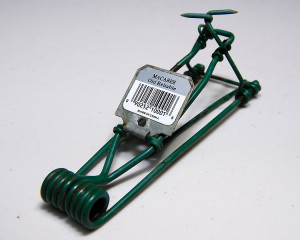
Macabee Trap - 'Old Reliable'...wasn't. We had poor success with this time-consuming trapping method.
Our soils here are friable, and it’s difficult excavating down to a horizontal run to place pairs of traps, without collapsing the tunnels completely. Macabee traps also aren’t very humane. They impale the gopher, but they’re not instantly killed. They bleed to death, slowly.
We had tried Cinch Traps, and had even less success with those. They are more humane, as they instantly kill the gopher, breaking its neck. What we didn’t realize was there is an art, and a science, to using Cinch Traps correctly, and successfully. Fortunately for us, we have an excellent local resource available, Thomas Wittman.
Thomas owns and operates Gophers Limited, in Felton, California. He teaches farmers, grounds keepers, and individual gardeners how to evaluate and control their own gopher populations. Desperate to squash the gopher problem that was gnawing its way across our orchard slope, we spoke with Thomas about doing an on-site evaluation and personal training session to teach us what we were doing wrong, so we could effectively trap our gophers. Thomas however recommended that we begin with one of his ‘starter kits’, which included two traps, a hori-hori knife, and an in-depth instructional DVD. If after watching the DVD we still weren’t successful at trapping gophers on the property, he’d be more than happy to set up a private consult.
We purchased his ‘Cinch Method Starter Kit’, and watched the video. We learned a lot more about gophers than we realized there was to know, and finally understood why our previous trapping attempts had been met with such limited success. Thomas taught us how to think more like a gopher, how to read important patterns in soil disturbances, and most importantly where to place the Cinch Trap, and how to properly set the trap for greatest success.
The next morning, eager to deploy our new found knowledge against the gophers that had previously outwitted us, we set two traps. Thomas demonstrates placing the Cinch Traps in this video excerpt.
We didn’t expect to be as successful as Thomas is in this video, as we hadn’t caught a gopher ourselves in months, but before lunch, we’d caught our first TWO pocket gophers in the orchard. Thomas’ kit had already paid for itself as we now had finally caught the most problematic gophers threatening our new fruit trees. As our gophers are killed without toxins, rather than bury them, we leave them at the soil surface. There are plenty of predators and scavengers here, and by morning they’re always gone.
Ever wonder why these little rodents are called pocket gophers? I’d never really thought about it before. Pocket gophers get their name from their extensive external cheek pouches. Fur-lined pockets that extend all the way back toward their shoulders. They can pack a lot of food into these pockets, and transport it through their burrows, leaving their teeth and claws free for digging.
We took a little video of our first two successful catches. The video starts with a gopher underground tugging on the roots of some weeds (you can see the plant ‘twitching’).
We don’t usually recommend specific products on our blog, but if you have a seemingly endless supply of gophers, and are interested in non-toxic control of your resident gopher population, we highly recommend Thomas Wittman’s DVD. It was a good investment for us, and we finally feel confident that we can keep our gophers under control. If you reside in the San Francisco Bay Area, Thomas also does presentations throughout the year, in various locations. See the Gophers Limited website for upcoming sessions.



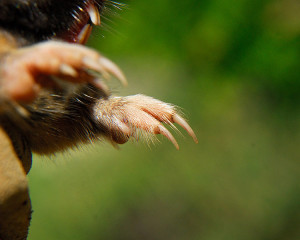
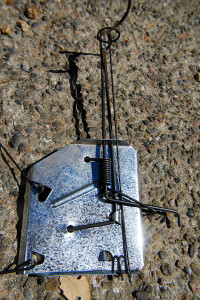
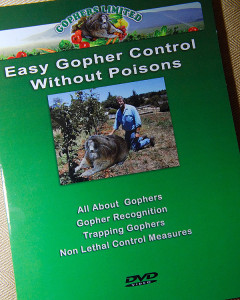
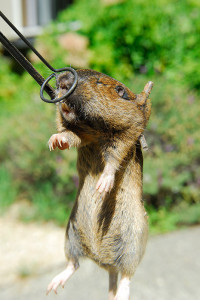
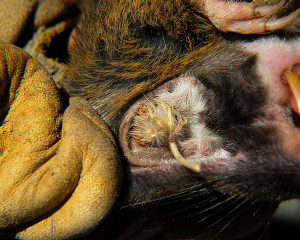








Dear Clare, I was too squeamish to look at the videos but I am certain that I would have steeled myself to watch the film,purchase a gopher extermination kit and employ the private gopher consultant if I had the problems that you outline here. Life is certainly never dull on Curbstone valley Farm!!
That’s alright Edith, it rather goes against my nature to intentionally set out to harm any animal. Unfortunately, gophers are like underground rats, and in the right environments their populations can become devastatingly overwhelming. As our fences now block many of their natural enemies from reaching them, in the gardens at least, we’re now stepping in as substitute ‘predators’.
I couldn’t watch the video either. You would think that I would be tougher after growing up on a farm, but I would always lock myself in the bathroom when my father would kill the chickens, too squeamish as well.
But I am really, really glad that I don’t have gophers!
I’m glad you don’t have gophers too…they’d think your lindens were tasty!
Wow, great work! I’m a little jealous of the pocket gopher’s “pockets.” Seems like something that could be useful at times!
…and they’re fur-lined taboot! Who doesn’t want fur-lined pockets? 😛
Just seeing a bobcat is special – capturing a successful hunt is too cool.
How about letting the local kids play whack a mole for prizes 🙂
I love the idea of whack-a-mole, not sure we have enough neighborhood kids though!
I agree, I’ve witnessed two different bobcats hunting, up close, in broad daylight. One for a nestful of birds, enough to wrench anyone’s heart, and this handsome chap gopher-nabbing. I’m always in awe when I get to see them hunt in person, as it’s not something you get to see everyday…not even around here.
Great pictures! The claws and teeth shot particularly delights me. I enjoy your thorough natural history run-downs… Of course, me loving toothy rodents so, I’d assumed the pocket part meant they were cute and small and could fit in one nicely. Now I know the truth… Go get those gophers!
I’m so glad your potholders have been returned to their originally intended use 😛 Yay you for finally catching Woodchuck Jr., they’re more wiley than our gophers!
Those first two photos are the scariest of them all! LOL
Aren’t they though? I almost dubbed the first one simply RAAAWWWRRRR! The second…”I’ll get you my pretty…mwahahahaha” 😛 It’s difficult to believe something the size of a small rat could be so darned destructive, but then again, we’ve had rodents do hundreds of dollars worth of damage to our vehicles since we moved here…the joys of living in the woods .
I think you would be hard pressed not to find any gardener who hasn’t had problem with gophers. We have had one or two, so our problem isn’t really a problem. You would think with how widespread gophers are that there would be more non-toxic and humane products on the market. You have done a huge service to everyone who deals with gophers by showcasing this product 🙂
I hope someone finds it useful. I really didn’t give much worth to the Cinch Traps, not realizing we weren’t deploying them correctly. Hopefully, if someone has tried and failed with the non-toxic trapping methods, they’ll take the time to learn how to use them properly, whether it’s through Thomas’ video, or somewhere else. They actually are very effective, when used properly.
Wow! Our gopher population is definitely increasing, but it’s not toooo bad yet! Great info, if we ever get to that level! And I certainly understand – we’re not out to kill them off, and we’re willing to ‘share’ some of the crop – but really!!!!!
Most of our crops are already protected from underneath with hardware cloth, the fruit trees have root-guards, but even then the little rodents will still occasionally hop over the barriers and harm trees and crops. I’m happy to leave most of the ‘control’ to the hawks and predatory mammals. Just trying to be surrogate trapper in the areas we’ve fenced off. Personally, I’d rather have more bobcats 😛
How close did that bobcat come to your camera? Did it step on your feet?
I’ve had one single gopher in my West Oakland garden. He eats a fair number of California Poppies, but I leave him alone, because I admire the fact that he can survive among the warehouses and railroad tracks.
http://howsrobb.blogspot.com/2007/08/gopher-it-dude.html
Well, if you took the exterior wall of the office away, he was within three feet. Any closer and the camera wouldn’t have been able to focus on him 😛 I was just grateful that after he caught the gopher, he walked toward the office window, rather than away. I can’t believe he didn’t see me!
They are remarkably adaptive creatures, hence their success. I hate to dislike an animal just because it’s successful. You’re right, for that they should be admired. I don’t dislike gophers, I just can’t believe sometimes how phenomenally successful they are, even when their local concentrations get so high. That’s when they become outright destructive. Pigeons with pockets LOL. 😛 I’m happy to have some here though, we need all the drainage improvements we can get!
Nice info on an animal most won’t blog about.
That’s an interesting point. I know there are a lot of gardeners out there with gopher woes, but I very rarely see them mentioned.
Wow…and I whine about moles, at least they don’t eat the plants just uproot them on accident!
What a great post, good for you, I hope your orchard will thank you will lots of lovely fruit for your stewardship! Kim
That’s an important distinction Kim. Many gardeners lump moles and gophers in the same heap on the destruction scale. Moles are actually very important for helping to keep pest bugs in check, even though they accidentally might over-aerate the odd plant or two. They, unlike gophers though, don’t directly eat the roots of your plants. Thomas’ video explains how to tell the difference between mole runs versus gophers, so you target the animal that’s actually doing the damage. Toxic control methods however, don’t discriminate between them.
Just moles in our garden too, lots of tunnels but that’s about it. The video of the bobcat catching the gopher was really interesting. Those traps definitely seem to do the trick.
I just loved the video of the bobcat pouncing on the gopher! No wonder you have Fort Knox for a chicken coop!! Thanks for sharing and I’m eagerly awaiting Fowl Friday. UDG
I can’t tell you how glad I am that I don’t have to deal with gophers. I just wouldn’t do very well at all. My rabbit situation is not all that bad after watching what you have to deal with on the farm. Sounds like you have found the right method and you have definitely done your homework.
You have bobcats, too. :/
As far as I know we do not have gophers here, though we have had vole problems. The feral cats may be dealing with the voles as I haven’t seen any lately.
Nature is all about balance, isn’t it? Too much of any one thing is usually not good in the long run.
Can we borrow your cats? 😛 We were watching a few voles up to no good near the house around dusk the other evening. Clearly our prey species seem to be outweighing our available predators this year!
Clare, I can’t wait to show this to my husband. We have had some success with Macabee traps, but with all this “food” I am providing the gophers we are having a difficult time keeping up with them.
Carla, what I really like about the Cinch Traps is you don’t have to dig up half your yard to place the trap. The gopher has already done the damage. Setting the traps is fast, and it’s easy to see when they’ve tripped. We’ve actually even heard them trip when we’re out in the orchard.
You say, “Five species of pocket gophers are found in California.” Are those native gophers? Or have they moved in from elsewhere? DO they prefer exotics or native plants?
Our pocket gophers are native Susan. I’ve read that some have looked into whether gophers prefer native versus exotic vegetation, but I haven’t read anything conclusive one way or the other. Here certainly, our native plants have been relished. The California poppies and native yarrow are all but gone. I watched one gopher drag an entire Achillea millefolium underground last spring. I blinked, and it was gone!
We don’t have gophers in my yard, but we do have ground squirrels (chipmunks) that dig holes everywhere. But the hawks, owls, and neighbor cats seem to be keeping their population in check. Occasionally I have also seen large garter snakes that will eat them. So for the most part things are kept in balance.
Good to know. We’re currently excluding them with hardware cloth in the bottom of raised beds. But if I get my “dream farm” one day, I’m sure it will be filled with gophers, so I might have to trap them like you are doing.
Clare we don’t have those little critters here thankfully – its just moles near us but from the video’s I’ve just watched it looks like its the most humane way to get rid of them from your property.
I wonder how many you’ve caught now since posting this? Some teeth! no wonder you don’t want them near your fruit trees.
Clare,
This is a very informative post about all things gopher. I’m glad you found a humane and effective solution to control their population. I’ve only seen one gopher (fingers crossed!)on our property over the past few years, probably because our soil is so rock hard in places, but am keeping a close eye, especially in the cultivated areas. Right now, we are raging a fierce battle with a population explosion of bunnies and squirrels on the grounds, which is fueling crittercidal thoughts in my husband. So we’ve thrown aesthetics out the window and decided to surround all our vulnerable plantings with a garrison of netting, chicken wire, fake owls, shiny streamers, pepper spray, blood meal, etc. Now, our ripening peaches and apricots are getting eaten by something, so we’ve set up a motion detector camera to catch the culprit(s) on film. Defeat is not an option!
Please know you are not alone, Clare! Can we talk about how hubby, after bombs, gum, pepper, etc., drove back & forth over holes at the lake (on a steep hill) with SUV, determined to rid these pests. Wish we had read this post first (and had a video camera) … no, hubby is not commited to the institution but is still on the prowl. Will forward this post to him 🙂
Oh, gophers! Nothing gets planted here without its metal mesh basket.
Good that you found the cinch traps and Gophers Limited products. We didn’t catch a gopher ever, even though they were hurting our trees, until we discovered this company. The cinch traps work wonders and now we can keep the gophers at bay.